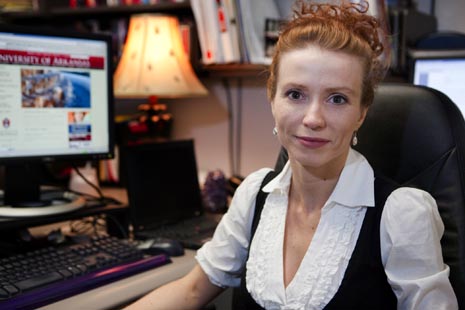
FAYETTEVILLE, Ark. – In Naked Lives: Inside the Worlds of Exotic Dance, sociologist Mindy S. Bradley-Engen reveals how the organization of an exotic dance establishment affects how the women who work there perceive their jobs.
“Dancers do not dance in a vacuum. Dancers work in clubs, under management, around customers and co-workers, under policies, and within formal and informal culture,” Bradley-Engen wrote. “My intent has been to unpack the complexity of dancing by detailing how the dancing experience is conditioned by the social environment in which it occurs.”
In the wide range of sociological research into working life, there has been limited study of sex work. Two main streams of thought dominate sex work research, according to Bradley-Engen. Former show-club dancers have tended to portray exotic dance as a positive, pro-sex occupation. Feminists concerned about women’s lives have tended to find exotic dance exploitative and degrading and the women powerless.
 |
“This book steps back and looks at the larger social context in a way that hasn’t been researched before,” Bradley-Engen said.
Her eight-year study of exotic dance clubs involved 50 formal interviews with dancers, informal interviews and field observations with dozens of others, 12 hours of recorded dressing room conversations, and observations from more than 50 clubs throughout the United States. Dancers ranged in age from 18 to 40, and the typical dancer had been dancing for about four years.
Her research revealed patterns of behavior and organization among dance clubs. Bradley-Engen identified three basic types of establishments, each with its own culture and working conditions: the hustle club, the show club and the social club.
Each club offers customers a different female stereotype. Women in hustle clubs are treated as sexual objects only. Dancers in show clubs appear as flawless goddesses and “above” the customer. In social clubs, the role of the women is to be like mothers or the girl next door.
Hustle clubs emphasize physical sexual gratification, and dancers have quotas for sales of alcohol and lap dances. The social world of the hustle club features a detached management style with minimal supervision and little monitoring of sexual activity, drug use or conflicts. The interaction between dancers is competitive and often hostile. While the earning potential is high, the turnover among dancers is also high.
Working in the hustle club environment, “dancers become disassociated with their labor and view their work, as well as others with whom they participate in this course of action, negatively,” Bradley-Engen wrote.
Show club management has highly selective criteria for dancers, including auditions and an emphasis on professional stage performance and appearance. Show club dancers make a significant investment in time, energy and effort to attain or maintain “perfection.” In addition to developing dance routines and purchasing expensive costumes, show club dancers often use cosmetic surgery to continue to meet the high standards of attractiveness.
As divas, dancers in show clubs are indifferent or negative toward their fellow dancers. It’s a competitive atmosphere, and the earning potential is high. Yet, Bradley-Engen wrote, “For many of the show club dancers, dancing is perceived less in terms of attractive financial alternatives and more in terms of validation and personal rewards.”
Social clubs offer the lowest financial rewards to dancers, yet the women who worked in social clubs had stronger ties with the other dancers and more positive attitudes toward customers and club management than did the dancers in hustle clubs or show clubs. The atmosphere is collective and friendly with a social focus. After taking her turn on the stage, a dancer may drink with customers or shoot a game of pool. Standards of appearance are looser than in hustle and show clubs, and dancers’ careers are consistently longer and more stable.
At smaller, stable social clubs, dancers “are more likely to maintain existing friendships, develop social networks, and have symmetrical power relationships with management.” Dancers often feel responsibility to both the club and its customers.
“My own and other studies demonstrate that exotic dance represents both a choice and a lack of choices. The next step is to uncover factors that underlie the disparities in experiences, understand the mechanisms involved, and examine how these conditions may be changing over time,” Bradley-Engen wrote.
Bradley-Engen has seen signs that the exotic dance business is changing, with “small entrepreneurial endeavors such as social clubs or sleazy under-regulated environments such as hustle clubs” giving way to multimillion dollar show club franchises. An example is Rick’s Cabaret International, which is publicly traded on NASDAQ.
Bradley-Engen is an assistant professor of sociology and criminal justice in the J. William Fulbright College of Arts and Sciences at the University of Arkansas. Her book was published by the State University of New York Press, Albany. On campus, it is available for sale at the University of Arkansas Bookstore.
Contacts
Mindy S. Bradley-Engen, assistant professor, sociology and criminal justic
J. William Fulbright College of Arts and Sciences
479-575-3776, mwbradl@uark.edu
Barbara Jaquish, science and research communications officer
University Relations
479-575-2683,
jaquish@uark.edu